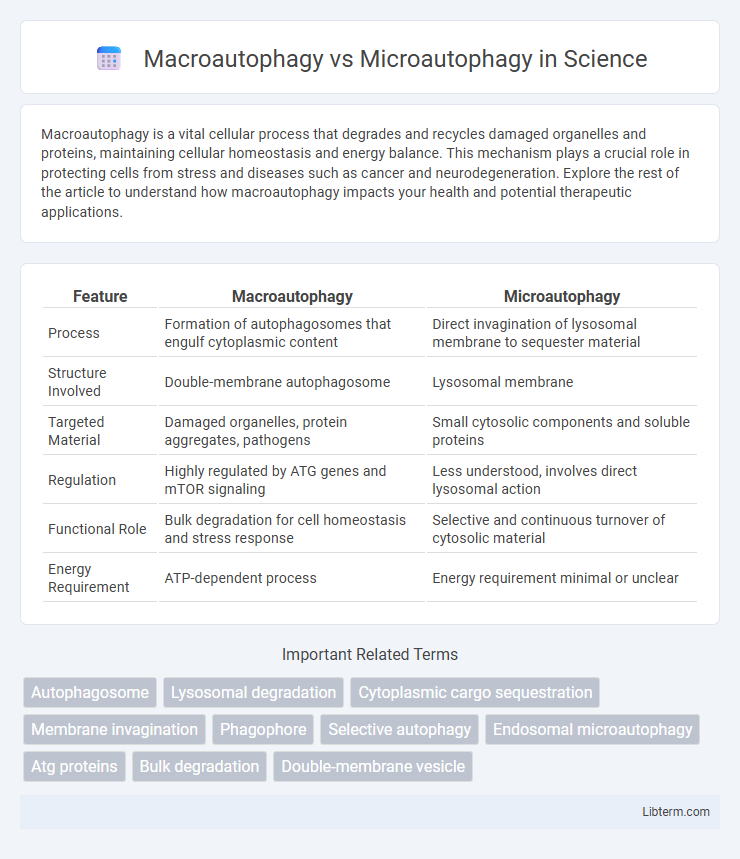Macroautophagy is a vital cellular process that degrades and recycles damaged organelles and proteins, maintaining cellular homeostasis and energy balance. This mechanism plays a crucial role in protecting cells from stress and diseases such as cancer and neurodegeneration. Explore the rest of the article to understand how macroautophagy impacts your health and potential therapeutic applications.
Table of Comparison
| Feature | Macroautophagy | Microautophagy |
|---|---|---|
| Process | Formation of autophagosomes that engulf cytoplasmic content | Direct invagination of lysosomal membrane to sequester material |
| Structure Involved | Double-membrane autophagosome | Lysosomal membrane |
| Targeted Material | Damaged organelles, protein aggregates, pathogens | Small cytosolic components and soluble proteins |
| Regulation | Highly regulated by ATG genes and mTOR signaling | Less understood, involves direct lysosomal action |
| Functional Role | Bulk degradation for cell homeostasis and stress response | Selective and continuous turnover of cytosolic material |
| Energy Requirement | ATP-dependent process | Energy requirement minimal or unclear |
Introduction to Autophagy: Overview and Importance
Macroautophagy involves the sequestration of cytoplasmic components into double-membraned autophagosomes for lysosomal degradation, whereas microautophagy directly engulfs substrates via lysosomal membrane invagination. Both processes are crucial for cellular homeostasis, enabling the recycling of damaged organelles and proteins under stress conditions. Efficient autophagic mechanisms maintain metabolic balance and protect against diseases such as neurodegeneration and cancer.
Defining Macroautophagy and Microautophagy
Macroautophagy is a cellular degradation process where cytoplasmic components, including damaged organelles and protein aggregates, are enclosed within a double-membrane vesicle called an autophagosome, which subsequently fuses with a lysosome for content breakdown. Microautophagy involves the direct engulfment of cytoplasmic material by the lysosomal membrane through invagination, protrusion, or septation, enabling the lysosome to sequester and degrade small portions of the cytoplasm. Both pathways maintain cellular homeostasis by recycling macromolecules but differ in vesicle formation and cargo sequestration mechanisms.
Mechanisms of Macroautophagy
Macroautophagy involves the formation of a double-membrane autophagosome that engulfs cytoplasmic components, which then fuses with lysosomes for degradation. This process is regulated by autophagy-related genes (ATGs) and signaling pathways such as mTOR and AMPK that control autophagosome initiation, nucleation, and elongation. In contrast, microautophagy directly engulfs cytosolic substrates through lysosomal membrane invagination, bypassing autophagosome formation.
Mechanisms of Microautophagy
Microautophagy involves the direct engulfment of cytoplasmic material by lysosomal membrane invagination, forming vesicles that sequester cellular components for degradation. This process relies on lysosomal membrane dynamics and is distinct from macroautophagy, which uses double-membrane autophagosomes to deliver cargo. The key mechanisms of microautophagy include lysosomal membrane deformation, vesicle scission, and the selective or non-selective uptake of targeted substrates into the lysosome for recycling.
Key Differences Between Macroautophagy and Microautophagy
Macroautophagy involves the formation of double-membrane autophagosomes that sequester cytoplasmic cargo for delivery to lysosomes, whereas microautophagy directly engulfs cytoplasmic components via lysosomal membrane invagination. Macroautophagy is often selective or non-selective for organelles and large protein aggregates, while microautophagy primarily mediates the continuous turnover of cytosolic components on a smaller scale. The regulation of macroautophagy is tightly controlled by autophagy-related (ATG) proteins, contrasting with microautophagy's more constitutive and less complex mechanism.
Cellular Functions and Roles in Homeostasis
Macroautophagy involves the formation of double-membrane autophagosomes that engulf cytoplasmic components, facilitating the degradation and recycling of large protein aggregates and damaged organelles to maintain cellular homeostasis. Microautophagy directly engulfs cytoplasmic materials through invagination of the lysosomal membrane, playing a crucial role in the continuous turnover of cytosolic components and fine-tuning of metabolic balance. Both mechanisms are essential for cellular quality control, stress response, and adaptation, ensuring the preservation of proteostasis and nutrient availability.
Regulation and Signaling Pathways
Macroautophagy is regulated primarily by the ULK1 complex and mTOR signaling pathway, which senses nutrient availability to initiate autophagosome formation. Microautophagy relies on direct lysosomal membrane invagination, regulated by ESCRT machinery and distinct signaling pathways such as TORC1 that modulate membrane dynamics. Both processes involve key regulatory elements like AMPK and PI3K complexes but differ in their activation mechanisms and cargo selection specificity.
Implications in Human Health and Disease
Macroautophagy involves the formation of double-membrane autophagosomes that engulf large cellular components, playing a critical role in clearing damaged organelles and protein aggregates linked to neurodegenerative diseases like Alzheimer's and Parkinson's. In contrast, microautophagy directly engulfs cytoplasmic material through lysosomal membrane invagination, contributing to cellular homeostasis and nutrient recycling, with implications in metabolic disorders such as diabetes. Dysregulation of both macroautophagy and microautophagy disrupts cellular quality control mechanisms, promoting the progression of cancer, infections, and age-related diseases.
Experimental Methods for Studying Each Pathway
Macroautophagy is commonly studied using assays such as transmission electron microscopy (TEM) for observing autophagosome formation and GFP-LC3 fluorescence microscopy to monitor autophagic flux. Microautophagy research often employs in vivo and in vitro assays including lysosomal uptake measurements and fluorescence-based vacuolar membrane invagination imaging. Techniques like immunoblotting of autophagy-related proteins and pharmacological inhibition further differentiate pathway-specific activities in experimental settings.
Future Directions and Therapeutic Potential
Macroautophagy and microautophagy represent distinct cellular degradation pathways with emerging therapeutic potential in neurodegenerative diseases and cancer. Advances in selective autophagy modulation and targeted drug delivery systems are poised to enhance specificity and efficacy in treating conditions linked to autophagic dysfunction. Future research aims to unravel molecular regulators and develop biomarkers to optimize clinical interventions harnessing both macroautophagy and microautophagy pathways.
Macroautophagy Infographic

 libterm.com
libterm.com